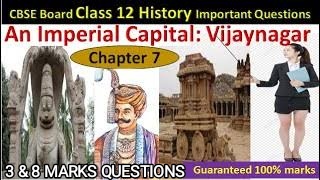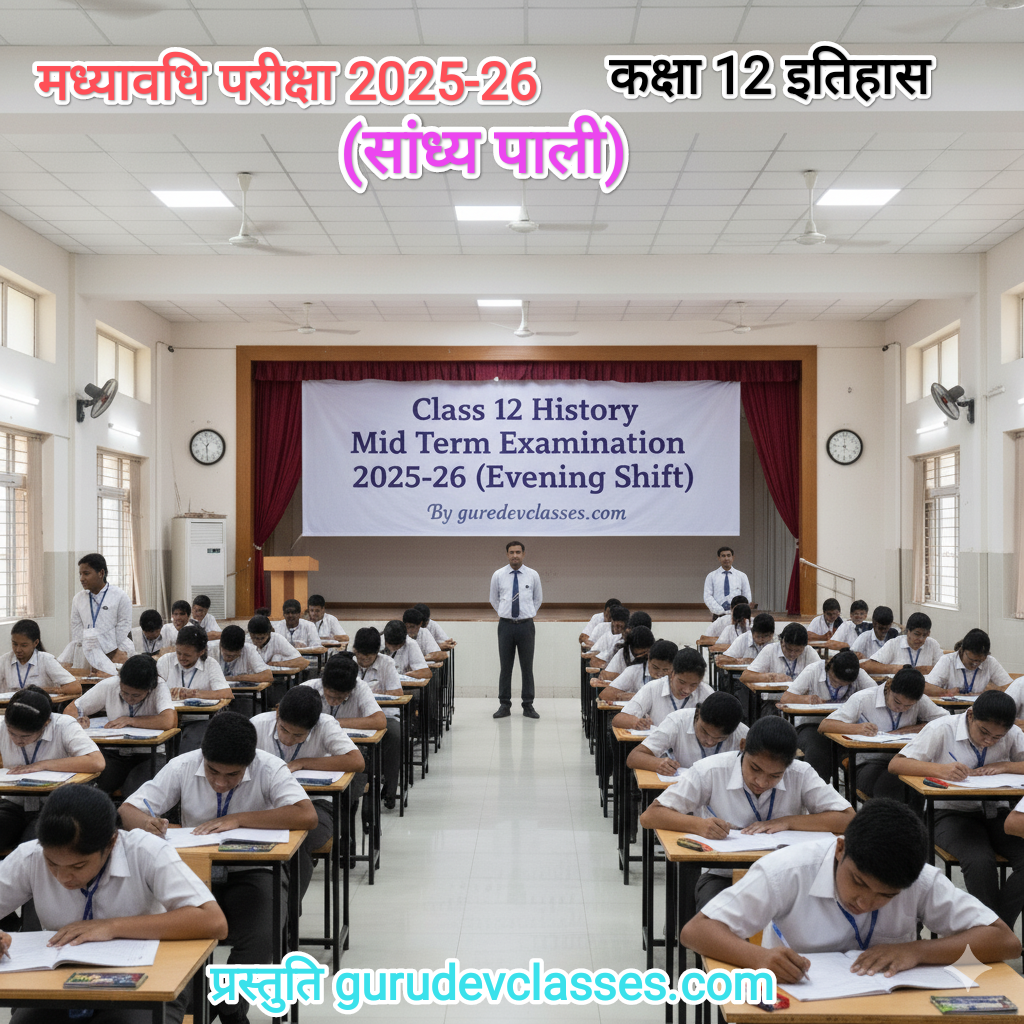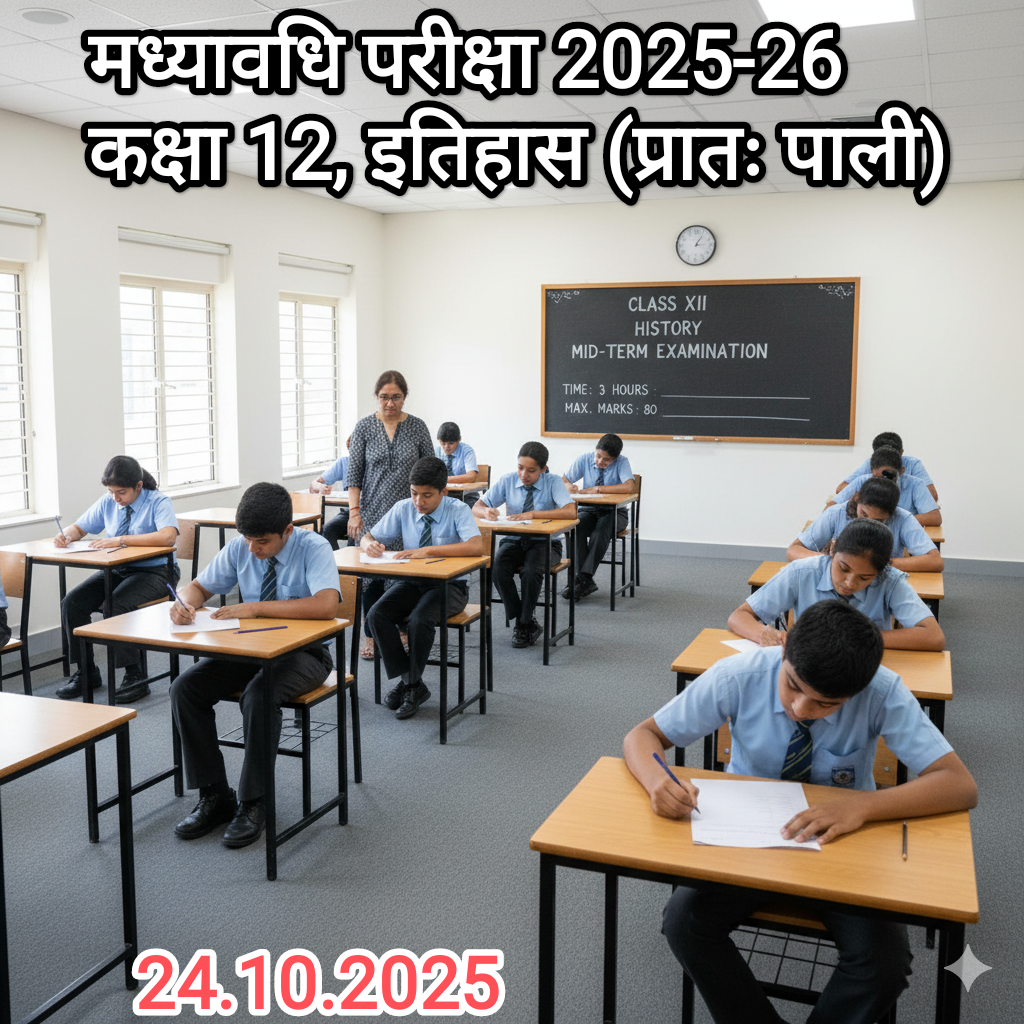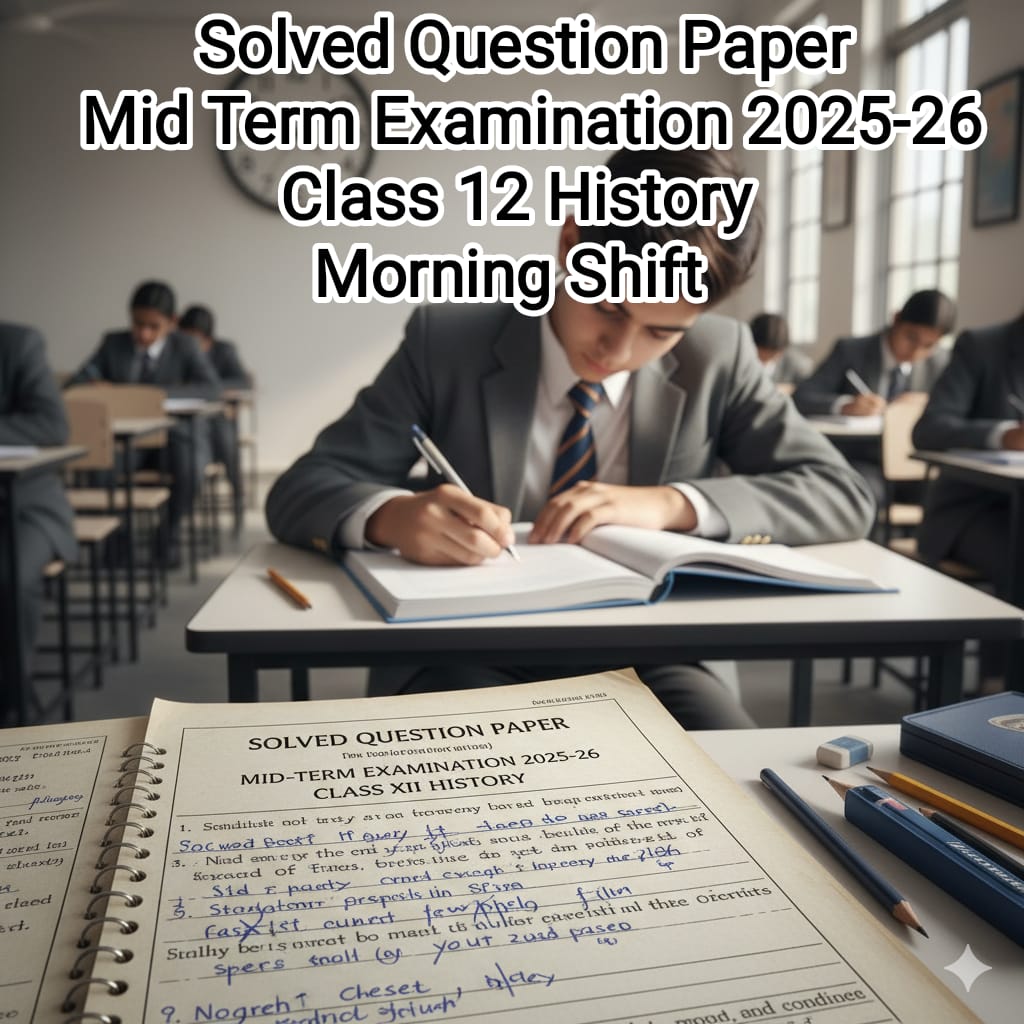Previous Years CBSE Board Questions (3 Marks & 8 Marks)
3-Marks Questions
Q1. Write a short note on the Rayas of Vijayanagara.
(Asked: 2000, 2008)
Answer :
- The rulers of Vijayanagara were called Rayas (meaning “king” or “chief”). They ruled from the 14th to 17th century.
- They were great patrons of art, literature, architecture, and religion; many temples, palaces, and irrigation works were constructed under their rule.
- Famous Rayas like Krishnadeva Raya consolidated the empire, promoted Telugu and Sanskrit literature, and expanded military power.
Q2. Mention any three sources used by historians to reconstruct the history of Vijayanagara.
(Asked: 2005, 2008,2012, 2013, 2017, 2019)
Answer :
- Archaeological Sources: Ruins of Hampi, temple remains, inscriptions, and sculptures help understand architecture, culture, and administration.
- Literary Sources: Works like Amuktamalyada (by Krishnadeva Raya), Raya Vachakamu, and Persian/Arabic writings.
- Foreign Accounts: Travelers like Domingo Paes, Abdur Razzaq, and Nicolo Conti described trade, society, and court culture.
Q3. Explain the role of trade in the prosperity of Vijayanagara Empire.
(Asked: 2009, 2015)
Answer :
- Vijayanagara had thriving inland and overseas trade—horses, spices, textiles, and precious stones were major commodities.
- Ports like Goa, Honavar, and Machilipatnam linked Vijayanagara to the Persian Gulf, Southeast Asia, and China.
- Trade revenue enriched the empire, financed temples, and strengthened the military power of the Rayas.
Q4. Mention three unique features of the Amara-Nayaka system.
(Asked: 2004, 2013, 2019)
Answer :
- Amara-Nayakas were military chiefs who controlled territories, collected taxes, and maintained soldiers.
- They provided troops to the king whenever required and were crucial in local administration.
- The system was similar to feudalism; though powerful, the king kept them under check by transferring them periodically.
Q5. Why was the battle of Talikota (1565) a turning point in Vijayanagara history?
(Asked: 2007, 2018, 2020)
Answer :
- The combined forces of the Deccan Sultanates defeated Vijayanagara, leading to the destruction of its capital Hampi.
- Temples, palaces, and markets were looted and destroyed, marking the decline of the city.
- Though smaller rulers continued, Vijayanagara never regained its former glory after this battle.
Q6. Explain any three features of Vijayanagara temple architecture.
(Asked: 2001, 2010, 2016)
Answer :
- Gopurams (Gateway towers): Massive, ornate towers with sculptures became distinctive features.
- Mandapas (Pillared halls): Used for dance, music, and community gatherings.
- Amman Shrines: Built for the consort of the deity, showing influence of Tamil traditions.
Q7. What were the main characteristics of the capital city of Vijayanagara?
(Asked: 2002, 2006, 2014)
Answer :
- The city was built along the Tungabhadra River and divided into the “sacred centre” (temples) and “urban centre” (royal enclosures, markets).
- Massive stone walls and fortifications surrounded the city, with seven concentric enclosures.
- It had an advanced water supply system, markets, palaces, and temples making it one of the wealthiest cities in Asia.
Q8. Explain any three causes of the decline of the Vijayanagara Empire.
(CBSE 2009, 2011, 2014)
Answer:
- Battle of Talikota (1565 CE): The decisive defeat of Vijayanagara forces by the combined armies of Bijapur, Ahmadnagar, Golconda and Bidar marked the beginning of its decline.
- Destruction of Hampi: After the battle, the victorious Deccan sultans plundered and destroyed Hampi, the imperial capital. Temples, palaces and markets were burnt, leading to economic collapse.
- Weak Successors: The later rulers lacked the ability of earlier kings. They could not revive the empire’s former glory, and regional governors declared independence.
Q9. Highlight any three features of the Mahanavami Dibba.
(CBSE 2015, 2017)
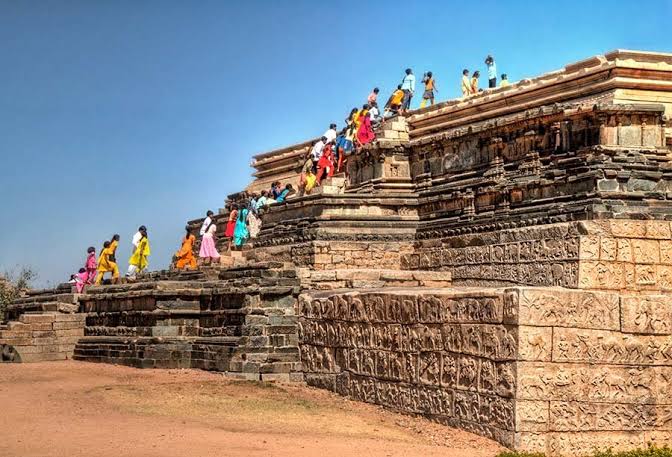
Answer:
- Royal Stage: It was a high platform used by kings to watch parades, dance performances, wrestling, and military reviews during Mahanavami (Dussehra).
- Symbol of Power: It showcased the grandeur of the Vijayanagara kings and the strength of their military.
- Decorated Structure: Its base is covered with carvings of horses, elephants, dancers, musicians, and army processions.
Q10. Describe any three distinctive features of the Virupaksha temple.
(CBSE 2012, 2018, 2020)
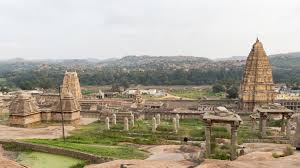
Answer:
- Oldest Temple: Virupaksha temple, dedicated to Lord Shiva, existed even before the Vijayanagara Empire, but it was expanded under Vijayanagara rulers.
- Tall Gopuram: The temple has an impressive entrance gateway with high gopurams (towers), decorated with sculptures.
- Active Worship: Unlike many other ruins, Virupaksha temple is still a living temple where daily rituals are performed.
Q11. Why did the rulers of Vijayanagara construct large tanks and canals? Explain any three reasons.
(CBSE 2007, 2016, 2021)
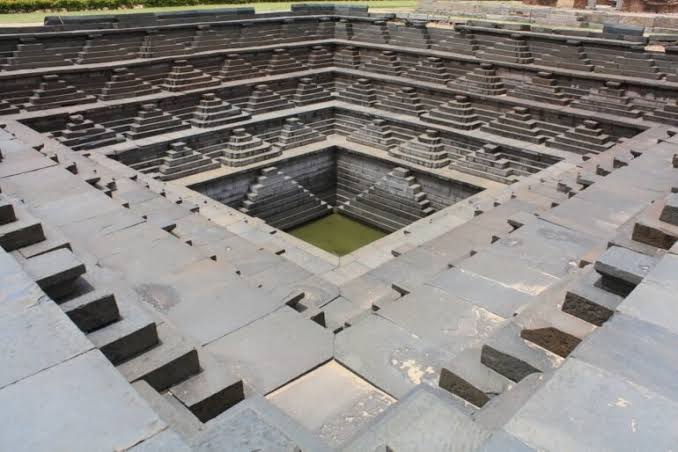
Answer:
- Irrigation Needs: The arid region around Vijayanagara required artificial irrigation; tanks and canals stored water for cultivation.
- Urban Population: Large population in the capital city required water supply for domestic use.
- Agricultural Surplus: To sustain trade, festivals, and state functions, agricultural productivity had to be increased through irrigation facilities.
8-Marks Questions (with detailed answers)
Q1. Describe the importance of foreign travelers’ accounts in reconstructing the history of Vijayanagara.
(Asked: 2000, 2008, 2014, 2020)
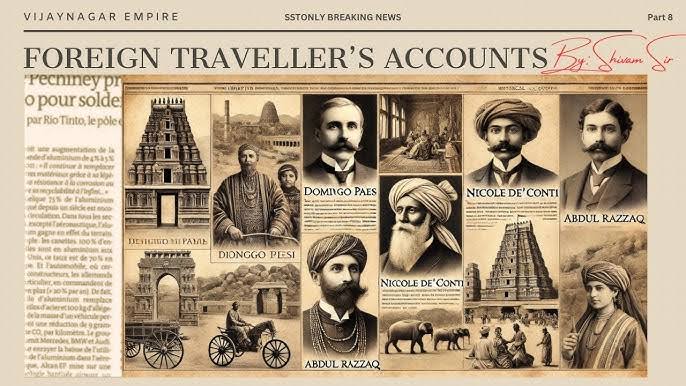
Answer :
- Travelers like Nicolo Conti, Abdur Razzaq, Domingo Paes, and Barbosa visited Vijayanagara between 15th–16th century.
- They provided eyewitness descriptions of its wealth, markets, palaces, and temples.
- Domingo Paes praised Krishnadeva Raya’s rule, military discipline, and economic prosperity.
- Abdur Razzaq (from Persia) described the grandeur of the city, trade, and court ceremonies.
- Barbosa recorded the importance of ports and maritime trade.
- Their accounts highlight social stratification, festivals, and cultural practices.
- These sources complement archaeological and literary evidence.
- Though they sometimes exaggerated, their writings remain invaluable for historians.
Q2. Explain the significance and features of the Amara-Nayaka system.
(Asked: 2003, 2009, 2017)
Answer :
- Amara-Nayakas were military chiefs granted land revenue in exchange for maintaining troops.
- They collected taxes from peasants, kept a share, and gave tribute to the king.
- They maintained armed retainers and fortified strongholds.
- The king rotated and transferred them to prevent rebellion.
- Their loyalty was tested in wars—providing crucial manpower.
- The system decentralized administration but ensured control at the local level.
- Similarities existed with European feudalism, where lords supported kings militarily.
- This system ensured Vijayanagara’s military strength for centuries.
Q3. Examine the features of temple architecture of Vijayanagara.
(Asked: 2005, 2012, 2018)
Answer :
- Temples were centres of worship, learning, and economic activity.
- Gopurams (gateway towers): Large, decorative entrances became iconic.
- Mandapas: Spacious pillared halls for cultural events.
- Kalyana Mandapas: Marriage halls dedicated to gods.
- Amman shrines: Reflect Tamil influence, built for goddess consorts.
- Sculpture depicted stories from epics (Ramayana, Mahabharata).
- Water tanks and irrigation linked temples with community life.
- Example: Hazara Rama temple with Ramayana reliefs, Vitthala temple with stone chariot.
Q4. How did water management play an important role in Vijayanagara?
(Asked: 2006, 2010, 2015, 2021)
Answer :
- Located in the dry Deccan, water supply was crucial for survival.
- Large tanks, canals, and aqueducts were constructed.
- Kamalapuram tank and Hiriya canal are notable examples.
- Temples often managed tanks, linking religion with irrigation.
- Water supported agriculture, ensuring food supply for population.
- Royal enclosures had separate water reservoirs.
- It supported gardens, ceremonies, and urban settlements.
- Efficient water system reflected advanced engineering and urban planning.
Q5. Discuss the reasons for the decline of Vijayanagara Empire.
(Asked: 2004, 2011, 2016, 2020)
Answer :
- Weak successors after Krishnadeva Raya.
- Growing discontent among Amara-Nayakas, leading to rebellions.
- Excessive military campaigns drained resources.
- Pressure from Deccan Sultanates (Bijapur, Golconda, Ahmadnagar, etc.).
- Defeat in the Battle of Talikota (1565) shattered military strength.
- Hampi was plundered, temples and palaces destroyed.
- Trade routes shifted to coastal powers (Portuguese, later Mughals).
- The empire fragmented into small Nayaka kingdoms.
Q6. Describe the main features of the administration of the Vijayanagara Empire.
(CBSE 2000, 2005, 2013, 2019)
Answer:
- Monarchy: The king was the supreme authority in political, military and religious matters.
- Council of Ministers: Assisted the king in decision-making; included high officials and nobles.
- Provincial Administration: Empire divided into rajya, nadu, sime, and grama. Local governors were appointed.
- Revenue System: Land revenue was the main source of income. Assessment was made based on land fertility and crops.
- Military Organization: Large standing army with cavalry, infantry, elephants and artillery. Amaranayakas (military chiefs) held land in exchange for maintaining troops.
- Judicial System: The king was the supreme judge. Brahmins often assisted in delivering justice.
- Capital City: Hampi served as the political and ceremonial hub.
- Religious Policy: Though Shaivism and Vaishnavism dominated, other sects were also patronized.
Q7. Explain the causes, events and results of the Battle of Talikota (1565 CE).
(CBSE 1998, 2004, 2011, 2018, 2022)
Answer:
- Causes:
- Expansionist policy of Vijayanagara under Aliya Rama Raya led to conflicts with Deccan Sultanates.
- Deccan states (Bijapur, Ahmadnagar, Golconda, Bidar) formed an alliance against Vijayanagara.
- Events:
- Battle fought at Talikota (1565 CE).
- Rama Raya led Vijayanagara army but was captured and executed.
- Massive destruction of Vijayanagara’s army followed.
- Results:
- Hampi was looted and destroyed.
- Decline of Vijayanagara began, though some rulers continued in southern territories.
- Shift of power balance to Deccan Sultanates.
Q8. “Krishnadeva Raya’s reign is considered the golden age of Vijayanagara.” Justify with examples.
(CBSE 2001, 2006, 2012, 2017, 2020)
Answer:
- Military Achievements: Defeated Bijapur, Golconda, Orissa, and subdued rebellious chiefs.
- Expansion of Empire: Brought most of South India under Vijayanagara control.
- Administration: Maintained efficient governance, reformed taxation, and encouraged agriculture.
- Trade & Prosperity: Encouraged foreign trade with Portuguese, Arabs, and others; export of spices, cotton, horses.
- Art & Architecture: Built the Vitthala temple with musical pillars, Hazara Rama temple, and expanded Virupaksha temple.
- Literature: Patron of Telugu, Kannada, Tamil, and Sanskrit scholars. He himself wrote Amuktamalyada in Telugu.
- Religious Tolerance: Honoured Shaiva, Vaishnava and Jain traditions.
- Cultural Flourishing: Poetry, dance, music, and temple art flourished.
Q9. “Vijayanagara was an important urban centre of trade and commerce.” Examine.
(CBSE 2002, 2008, 2014, 2019, 2021)
Answer:
- Strategic Location: Situated near Tungabhadra river and natural granite hills, which protected and facilitated trade.
- Markets & Bazaars: Hampi had well-planned markets like Virupaksha Bazaar where precious stones, horses, silk, spices were traded.
- Foreign Trade: Arab, Portuguese, and Persian traders visited regularly.
- Craft Production: Cotton textiles, metal work, and ivory carving were important crafts.
- Revenue from Trade: Customs duty was collected; trade brought immense prosperity.
- Agricultural Surplus: Irrigation projects ensured food supply, supporting trade.
- Traveler Accounts: Domingo Paes and Fernao Nuniz described the bustling markets of Hampi.
- Cosmopolitan Culture: Traders from diverse regions resided, making it a global trade centre of medieval India.
